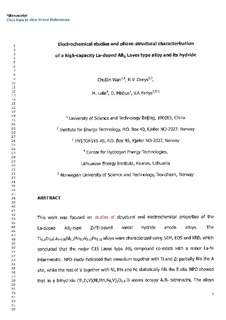| dc.contributor.author | Wan, ChuBin | |
| dc.contributor.author | Denys, Roman Volodymyrovich | |
| dc.contributor.author | Lelis, M. | |
| dc.contributor.author | Milcius, D | |
| dc.contributor.author | Yartys, Volodymyr | |
| dc.date.accessioned | 2019-10-08T08:47:04Z | |
| dc.date.available | 2019-10-08T08:47:04Z | |
| dc.date.created | 2019-04-23T09:26:25Z | |
| dc.date.issued | 2019 | |
| dc.identifier.citation | Journal of Power Sources. 2019, 418 193-201. | nb_NO |
| dc.identifier.issn | 0378-7753 | |
| dc.identifier.uri | http://hdl.handle.net/11250/2620783 | |
| dc.description.abstract | This work was focused on studies of structural and electrochemical properties of the La-doped AB2-type Zr/Ti-based metal hydride anode alloys. The Ti0.2Zr0.8La0-0.05Ni1.2Mn0.7V0.12Fe0.12 alloys were characterized using SEM, EDS and XRD, which concluded that the major C15 Laves type AB2 compound co-exists with a minor La-Ni intermetallic. NPD study indicated that vanadium together with Ti and Zr partially fills the A site, while the rest of V together with Ni, Mn and Fe statistically fills the B site. NPD showed that in a trihydride (Ti,Zr,V)(Ni,Mn,Fe,V)2D2.9 D atoms occupy A2B2 tetrahedra. The alloys were characterized during high-rate discharge and on cycling. La addition resulted in a significant improvement of the activation performance caused by a catalytic influence of LaNi hydride. The highest content of La greatly accelerated the activation, but it also caused an obvious decrease in discharge capacity and cycling stability. The alloy with an optimized La addition (x = 0.03) demonstrated a maximum discharge capacity of 420 mAh g−1 and the discharge capacity maintained at 79% at 0.71 C, while the capacity retention after 500 cycles was also high, 63%. Based on the EIS results, we conclude that the decay of the alloy electrode is related to the irreversible capacity loss and its pulverization. | nb_NO |
| dc.language.iso | eng | nb_NO |
| dc.publisher | Elsevier | nb_NO |
| dc.rights | Attribution-NonCommercial-NoDerivatives 4.0 Internasjonal | * |
| dc.rights.uri | http://creativecommons.org/licenses/by-nc-nd/4.0/deed.no | * |
| dc.title | Electrochemical studies and phase-structural characterization of a high-capacity La-doped AB(2) Laves type alloy and its hydride | nb_NO |
| dc.type | Journal article | nb_NO |
| dc.type | Peer reviewed | nb_NO |
| dc.description.version | acceptedVersion | nb_NO |
| dc.source.pagenumber | 193-201 | nb_NO |
| dc.source.volume | 418 | nb_NO |
| dc.source.journal | Journal of Power Sources | nb_NO |
| dc.identifier.doi | 10.1016/j.jpowsour.2019.02.044 | |
| dc.identifier.cristin | 1693356 | |
| dc.relation.project | Norges forskningsråd: 234246 | nb_NO |
| dc.relation.project | Norges forskningsråd: 257653 | nb_NO |
| dc.description.localcode | © 2019. This is the authors’ accepted and refereed manuscript to the article. Locked until 21.2.2021 due to copyright restrictions. This manuscript version is made available under the CC-BY-NC-ND 4.0 license http://creativecommons.org/licenses/by-nc-nd/4.0/ | nb_NO |
| cristin.unitcode | 194,0,0,0 | |
| cristin.unitname | Norges teknisk-naturvitenskapelige universitet | |
| cristin.ispublished | true | |
| cristin.qualitycode | 1 | |

